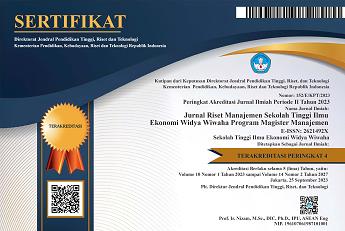PENGARUH IKLAN LAYANAN MASYARAKAT TERHADAP SIKAP DENGAN DISONANSI KOGNITIF SEBAGAI PEMODERASI
DOI:
https://doi.org/10.32477/jrm.v7i1.185Keywords:
public service ads, attitude, cognitive dissonanceAbstract
This study analyzes the effect of public service ads on the attitudes of students with cognitive dissonance (Cognitive Dissonance) as moderating in the city of Yogyakarta. This study took a sample of students in the city of Yogyakarta from Diploma to S3. Samples were distributed to 250 respondents, but only 223 were processed. The sampling method using a non-probability sampling approach was purposive sampling. Before the data analysis is performed first, the validity and reliability test is performed, in the validity test two approaches are used, namely using Pearson’s Coefficient Correlation and Confirmatory Factor Analysis (CFA). ILM3 and CD1 are invalid, the rest are valid, while the validity with CFA found three invalid statement items namely ILM2, CD1, CD2 and the rest are all valid. ILM reliability tests are all reliable above 0.6. This study uses multiple regression analysis with the help of the SPSS series 23 program, the results of multiple regression shows there is an influence of Public Service Advertising (PSA) on Student Attitudes (SK), while Cognitive Dissonance does not significantly affect the relationship between Public Service Adverts and Student Attitudes. For hypothesis testing only the first hypothesis is proven, the other hypotheses are not proven.
References
Agung A.M.L. ( 2001). “Manajemen Periklanan.” Usahawan. No.04 (April) h. 12-13.
Assael Henry. (1998). Consumer Behavior and Marketing Action, 6 th ed. Cincinnati. Ohio: South-Western College Publishing.
Berkman. H.W & Gilson. C. (1986). Concumer Behavior Concepts and Strategies. Boston: Ken Publishing Company
Bickford, Patricia. (2005). “Cognitive Dissonance in Religion”. Http:// people.bu.edu/bickpl/research.htm
Cooper, Donald R. dan Emory. C.William (1996). Metode Penelitian Bisnis. ed.5. Jakarta: Erlangga.
Dharmmesta, B.S. (1999). “Loyalitas Pelanggan: Sebuah Kajian Konseptual Sebagai Panduan bagi Peneliti.” Jurnal Ekonomi dan Bisnis Indonesia.” Vol.14.No.3. h.73-78
Gilovich, T.V.H.and Chen. S (1995). “Commission. omission. And dissonance reduction: coping with regret in th e “Monty Hall” problem.” Personality & Social Psychology Bulletin. 21. pp.182- 190
Hair.J.F.Jr. Anderson. R.E.Tatham.R.L. and Black. W.C. (1998). Multivariate Data Analysis. 5th ed. New Jersey: Prentice- Hall International. Inc.
Indriantoro, Nur dan Supomo, Bambang (1999). Metodologi Penelitian Bisnis: Untuk Akuntansi dan Manajemen. Yogyakarta: BPFE
Japarianto, Edwin (2006). “Analisis Pembentukan Disonansi Kognitif Konsumen Pemilik Mobil Toyota Avanza.” Jurnal Manajemen Pemasaran. Vol.1. No.2. Oktober. hal: 81-87
Kasali, Rhenald (2001). “Penggunaan Cognitive Dissonance dalam Kampanye Pemasaran.” Usahawan. No.10 (Oktober). h.39-43
Khairifa, Fenni (2007). “Penyampaian IKlan Layanan Masyarakat Kepada Khalayak.” Jurnal Harmoni Sosial. Mei.Vol.1 No.3
Khusnaeni, Nuri Luluk. Yulianto Edy dan Sunarti (2017). “Pengaruh Iklan Terhadap Sikap Suka Konsumen Serta Dampaknya pada Keputusan Pembelian.” Jurnal Administrasi Bisnis (JAB). Vol.47. No.2. Juni
Kotler, Philip (2000). Marketing Management: Analysis. Planning. Implementation. and Control. The Millennium Edition. Upper Saddle River. New Jersey: Prentice-Hall. Inc.
Kotler, Philip dan Susanto (2001) Manajemen Pemasaran di Indonesia. Jakarta: Salemba Empat.
Loudon, D.L. & Della Bitta. A.J. (1993). Concumer Behavior Concepts and Applications. 4thed. Singapore: Mc Graw-Hill Inc.
Louie, Aaron J (1997). “The Role of Cognitive Dissonance in Decision Making.” http:// www. Aaron Louie - Cognitive Dissonance in Decision Making.htm
Mowen, John C. (1995). Cosumer Behavior. Fourth Edition. Prentice-Hall International.
Neonisa, Didier (2011). “Peran Iklan Layanan Masyarakat Dalam Sosialisasi Program Busway oleh Pemprov DKI: Proses Sosialisasi Program Busway.” Humaniora. Vol.2. No.2. Oktober. hal: 1446-1466
Pawitra, Teddy. (2001). “Manajemen Pemasaran di Indonesia Masa Lampau. Kini dan Masa Mendatang.” Usahawan. No.10. (Oktober) h.32-38
Runtiko, Agus Ganjar (2013). “Desain Iklan Layanan Masyarakat Pemerintah.” Jurnal Penelitian Komunikasi. Vol.16 No.1. Juli. hal:21-38
Qolbi, Ummas Sahibul. Fauzi Achmad dan Sunarti (2014). “Pengaruh Iklan Terhadap Sikap Konsumen.” Jurnal Administrasi Bisnis (JAB). Vo.10 No.1. Mei
Sekaran, U.. (2000). Research Methods For Business: A Skill Building Approach. 3rd ed. John Wiley and Sons. Inc.
Sutisna (2001). Perilaku Konsumen dan Komunikasi Pemasaran. Bandung: PT Remaja Rosdakarya
Wijayanto. I.Putu M.(1997). Membangun Superior Value melalui Brand di Tengah Persaingan Jasa Kurir Global. Usahawan. No.10 (Oktober). h.37-40









